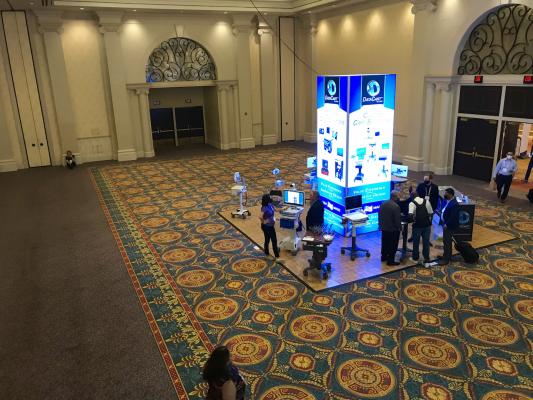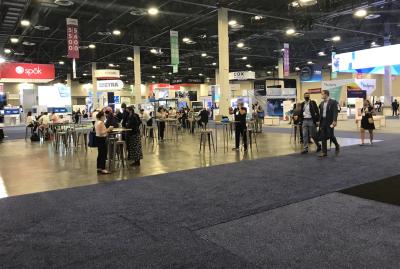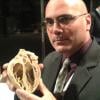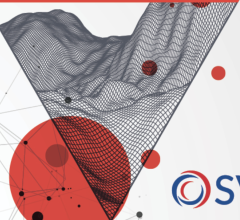
A lone vendor booth in a sea of open space in a corner of the expo floor at HIMSS 2021 this week. A large number of vendors decided to pull out of exhibiting at HIMSS in recent weeks because the host city of Las Vegas saw a major surge of COVID cases over July, reaching a 20.2% positivity rate on the day HIMSS began.
The in-person 2021 Healthcare Information Management Systems Society (HIMSS) meeting planned for Aug. 9-13 appeared to be the light at the end of the tunnel in the COVID-19 pandemic a few months ago. It was a sign that things will get better. And this appeared to be reflected with the virus cases dropping significantly since January 2021, due to the roll out of the vaccines. By June it appeared the pandemic was close to being over. HIMSS signaled the end of virtual medical meetings and a return to face-to-face conferences. It seemed fitting that this was the first large-scale medical meeting since more than a year and one-half, since it was the first large conference to cancel just a few days before it was to begin in 2020 due to the start of COVID.
However, that was about to change, starting in early July a month before the meeting, when pandemic cases began to rapidly rise again. I made several observations while attending HIMSS this week, and the experience may offer insights into things to come for in-person healthcare conferences. Here are some key takeaways.
New COVID Waves Will Slash Conference Attendance
In normal times in 2019, HIMSS attracted more than 30,000 healthcare system and hospital attendees, and likely as many, if not more, vendors to work the more than 1,400 vendor booths on the expo floor. This year, HIMSS said in the days prior to the conference, the total number of people attending its in-person portion of the meeting was about 17,500. But, this included attendees and vendor staff combined. HIMSS said the final count of exhibiting vendors was more than 700, which is about a 50 percent decrease from what was there in 2019. Additionally, it appeared most vendors cut back significantly on the amount of booth space they had.
For being in the middle of a pandemic, the in-person attendance was still pretty sizable, but represents a major reduction from the pre-pandemic levels of the 2019 meeting.
HIMSS clearly had planned for a large, normal pre-pandemic year conference, with large blocks of hotel rooms, numerous tour buses to transport people on several hotel bus routes, information desks and "ask me" people to help guide attendees, and the anticipation of a large amount of meeting and expo space booked. However, a good portion of this capacity appeared to go unused as open space.
I never saw more than five people on the buses I rode. I tried to attend a couple sessions and found they had been cancelled, or the speaker did not show up to present. There also was no waiting in line to get food on the show floor. The volume of traffic for the food vendors was so low that on the last day of the conference, one of the food courts at the front of the hall was completely closed.
At the in-person Heart Rhythm Society (HRS) 2021 meeting in July, one of the key vendors attending said traffic on the expo floor there was down by at least 40 percent from pre-pandemic years. The meeting took place in Boston where COVID numbers where low, but cases were starting to rise at a significant rate in other states by the time HRS took place.
A spike in COVID cases in Las Vegas led the city to require masks for all businesses, and it was quickly followed by a state mandate requiring masks for everyone, regardless of vaccination status, indoors. Here is a masking sign on the Las Vegas airport terminal train. Signs promoting masking, vaccinations and COVID testing were everywhere at the airport to greet visitors attending HIMSS. Photo by Dave Fornell.
Conferences Cannot Anticipate New COVID Waves
A few months ago, when many were planning to attend HIMSS, the COVID-19 vaccines appeared to doing great job of ending the pandemic. Positive cases and hospitalizations plummeted this past spring and by May and June masking requirements and restrictions on gatherings, restaurants and bars were all relaxed. It appeared that HIMSS would be the first large-scale, post-pandemic healthcare conference in August 2021.
However, starting in July, there was a sudden, massive uptick in new COVID cases, almost entirely driven by the new delta variant of the virus. The infection was fueled by people who were not vaccinated, making up 90 percent or so of new cases, and nearly all hospitalizations.
The HIMSS host city of Las Vegas rapidly became a major hot spot for the new wave of virus cases, with numbers rising each day closer to the conference. The positivity rate for new cases was 20.2 percent on the start of the week for the conference, held Aug. 9-13.
COVID Spike Now Requires Face Masks at In-person Medical Conferences
Two weeks prior to HIMSS, numbers in Las Vegas spurred the city to require all businesses to have their employees mask. Las Vegas has been resistant to requiring masks so it does not impact its vital flow of tourists, but the numbers just became to bad to ignore. The mayor of Las Vegas also contracted COVID during this latest wave.
Just a few days later, the CDC changed its masking guidelines and Nevada immediately adopted the new requirement to wear masks. This requires everyone, regardless of vaccination status, to wear a mask at all times inside buildings in areas with high infections rates.
Masks with the HIMSS logo where distributed in the show bags given to people as they check in at registration. Masks were also widely available as a booth giveaway on the expo floor.
This week, two other large medical conferences announced they too will require masks at their meeting this fall, the Radiological Society of North America (RSNA), the world's largest radiology conference, and the American Society of Radiation Oncology (ASTRO), the world's largest radiation therapy conference. Both conferences will be held in Chicago, ASTRO in October and RSNA the week of Nov. 29.
Masks are not new for anyone involved in healthcare this past year, even support staff in back offices were required to wear them in most health systems. However, they can still be uncomfortable to have a conversation in and muffle words, especially with the background noise of the expo floor. For this reason, on the HIMSS show floor, having conversions in walled meeting rooms in the booth or just off the show floor was a preference among most vendors I visited.
 Requiring Vaccinations to Attend Healthcare Conferences
Requiring Vaccinations to Attend Healthcare Conferences
HIMSS was the first large medical conference to require proof of vaccination in order to attend. This requirement was for both attendees and vendors. Option one was to download the COVID vaccine verification service app from the vendor Clear and upload images of your vaccination card and have the app shoot a photo of you to create a digital photo ID. Or, attendees had to bring their vaccination information in person at the conference for scrutiny.
Also at HIMSS 2021, there was a new check-in desk all attendees had to stop at first before getting into line to pick up badges. They had to show their Clear app verification on their mobile phone, or show their vaccination card.
Clear is best know for its airport security app, where airline travelers who want to pay for the service, can have all their personal information verified by the company and they show the verification as a safe frequent air traveler to the TSA to breeze through airport security lines, faster than TSA-Pre verified flyers. The company now offers the COVID vaccination app, where the company will verify the information on a vax card is legitimate.
As HIMSS was ongoing this week, vendors on the floor received emails from RSNA and ASTRO that both will now require COVID vaccination verification to attend, along with masks.
On Tuesday, the Vascular Interventional Advances (VIVA) conference, set for October in Las Vegas, also announced it will now require vaccination verification for all attendees.
For the time being, it appears vaccination requirements are becoming popular in an effort to make conferences as safe as possible for attendees.
Positive Attendee COVID Cases Reported After the Conference
Despite the vaccination requirement and masks, HIMSS announced one attendee tested positive on the last day of the conference and two have since tested positive the week following the conference. A vendor I met at HIMSS with also contacted me and told me a person I met with has tested positive for COVID.
The CDC changes it masking guidance three weeks ago to require masks for everyone indoors in high-transmission areas based on a study published in late July. This study of a mass spreader event in Massachusetts with more than 400 positive cases of the delta variant showed that more than 70% of those who tested positive where vaccinated.
In-person Medical Conferences Will See Fewer Vendors and Attendees
In many ways, the lead up in the last month to the 2021 HIMSS meeting mirrored the lead up to the planned March 2020 meeting. Last year, as COVID cases rose rapidly worldwide and then in the U.S., attendees and vendors began to seriously question attending. Like a wildfire, healthcare systems everywhere began restricting travel for staff in March 2020, so attendee cancellations began pouring into HIMSS. Vendors, faced with the cancellation of all, or nearly all, of their meetings with hospitals also began pulling out. This landslide of cancellations and rising COVID cases led to the cancellation of the meeting just a few days before it was to begin. This led to a domino effect immediately after, with all major healthcare conferences world-wide cancelling their meetings or going virtual. But this year, HIMSS held steady and decided the show must go on, and it did.
This came at a cost to some extent, as many vendors still decided to pull out in the week or two leading up to the conference. All of the vendors I spoke with said they were closely watching others pulling out and cancelations by hospitals they had meetings with, and nearly all of them debated pulling out of the show themselves.
In the past when HIMSS was in Las Vegas, it filled four exhibit halls wall-to-wall. The Sands convention center at the Venetian was a massive maze of vendors on the main show floor that took several days to walk in its entirety. This year it took a day and a half, at most. This year, HIMSS likely could have gotten away with concentrating the vendors and the smaller on-floor presentation theaters in the single, main expo hall and a smaller neighboring ballroom.
 The main expo hall concentrated vendors toward the front of the hall by the entrances and in the center, leaving vast gaps to the walls. Things were more spread out and there was a large number of large "lounges" with tables and chairs, or in some cases just large 20 x 20 or 40 x 40 for squares of open space where booths were supposed to be. For once, in nearly 15 years of attending HIMSS, there was plenty of places to sit down and social distance.
The main expo hall concentrated vendors toward the front of the hall by the entrances and in the center, leaving vast gaps to the walls. Things were more spread out and there was a large number of large "lounges" with tables and chairs, or in some cases just large 20 x 20 or 40 x 40 for squares of open space where booths were supposed to be. For once, in nearly 15 years of attending HIMSS, there was plenty of places to sit down and social distance.
Some vendors found themselves as what appeared to be distant islands separated from the rest of the show floor and other vendors by large canyons of open floor space.
Philips Healthcare and Nuance pulled out the Thursday before the meeting, going entirely virtual with meetings and demos. GE Healthcare and Agfa both abandoned their booth space and instead set up a small demo area in secluded meeting rooms to keep the appointments with the hospitals that were still attending in person.
The lower level show floor at the Sands a few years ago contained hundreds of smaller companies. But that expo floor was not used. The vendors that planned to exhibit there were moved to the main floor. Separate, smaller show floors for cybersecurity and new startup companies also had large open spaces and empty booths.
The COVID spike also appears to have impacted attendees. Two physicians who planned to attend the conference to present on IT topics I had interest in for cardiology and radiology ended up not attending.
Fewer Attendees, But More Meaningful Discussions
I asked several vendors how the meeting was going for them. The universal response was that while the number of people coming through their booths was drastically reduced, there were far fewer "tire-kickers" and more meaningful discussions and focused leads.
While they said most conversations were more serious and at a higher level than people just passing by and asking a basic question, they said it remains to be seen if the few qualified leads they received translate into sales. They said that will be a key question when they consider attending and what size their booth should be at subsequent medical conferences over the next year. They said they need to justify the cost of setting up a large, expensive booth and the expense of flying in sizable numbers of employees to staff it.
One mid-sized vendor I spoke with said they had four solid leads for new business over the four days of the HIMSS expo. They said if these do not translate into future business, they will serious question the need for a larger booth and the number of staff they bring to HIMSS or other shows in the future.
View a Photo Gallery of New Technologies at HIMSS 2021
Related Content:
RSNA 2021 Will Require Proof of Vaccination, Masks
Virtual Cardiology Meetings During COVID-19 Allowing More International Attendance
ACC Abandons In-person Meeting and Goes Entirely Virtual for 2021 Due to COVID
Virtual Cardiology Meetings During COVID-19 Allowing More International Attendance
VIDEO: What to Expect at the Virtual TCT 2020 Meeting — Interview with Juan Granada, M.D.
VIDEO: Insights Into How HRS Organized its Virtual Meeting — a discussion with Andrew D. Krahn, M.D. on lessons learned from the 2020 Heart Rhythm Society (HRS) virtual meeting.




 June 08, 2023
June 08, 2023 
